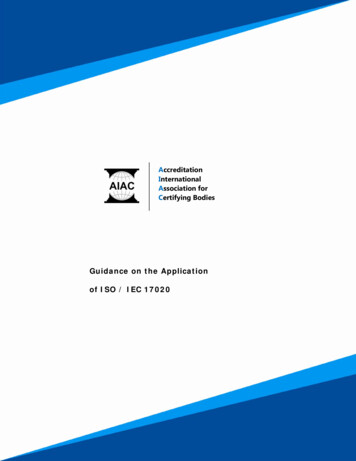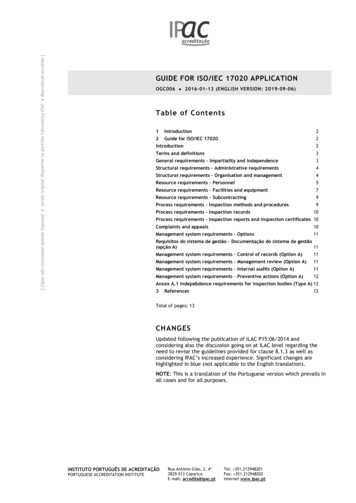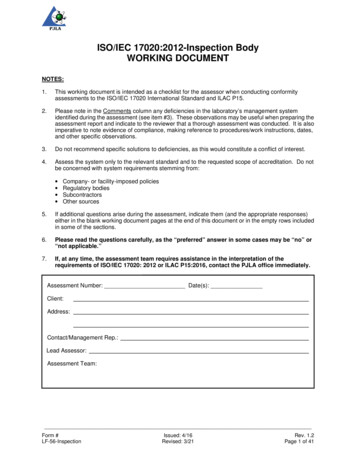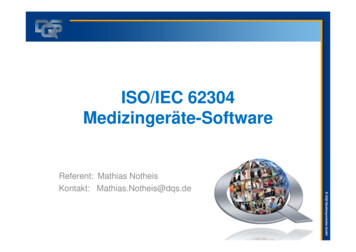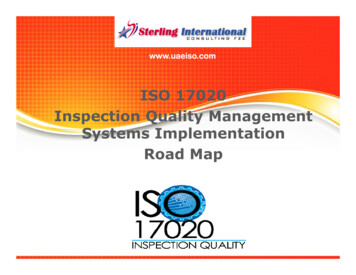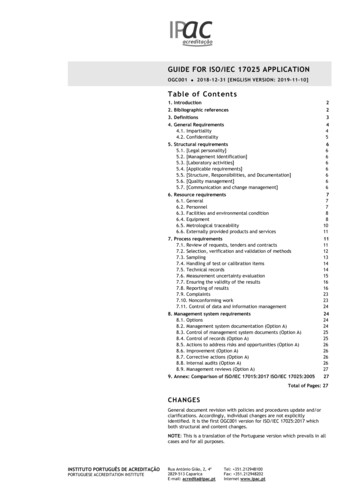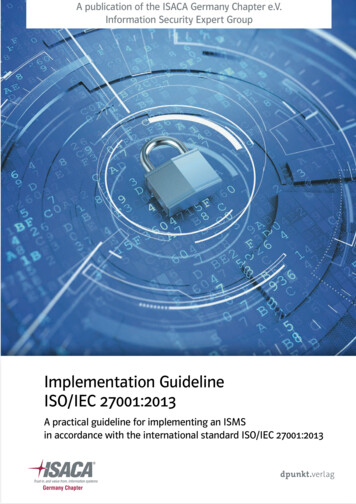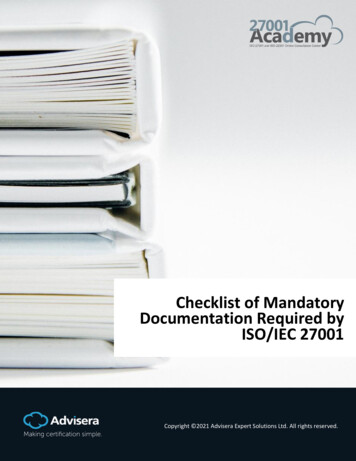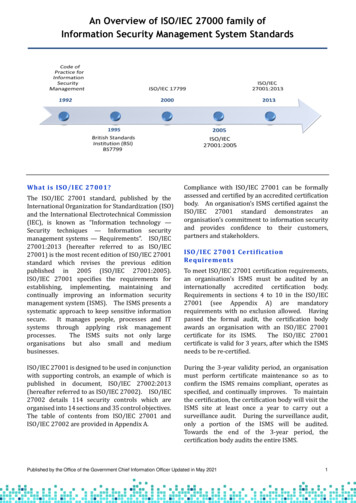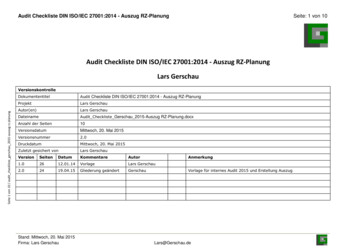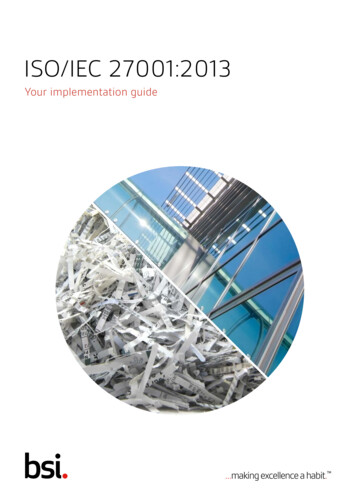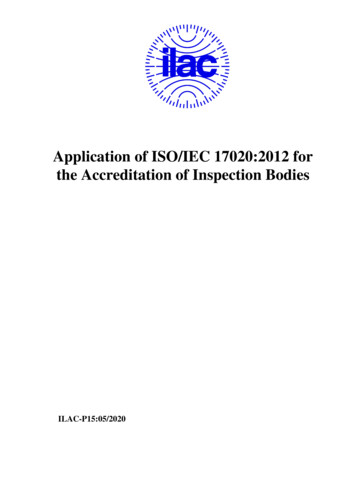
Transcription
Application of ISO/IEC 17020:2012 forthe Accreditation of Inspection BodiesILAC-P15:05/2020
About ILACILAC is the global association for the accreditation of laboratories, inspection bodies, proficiency testingproviders and reference material producers, with a membership consisting of Accreditation Bodies (ABs) andstakeholder organisations throughout the world.It is a representative organisation that is involved with: the development of accreditation practices and procedures, the promotion of accreditation as a trade facilitation tool, supporting the provision of local and national services, the assistance of developing accreditation systems, the recognition of competent testing (including medical) and calibration laboratories, inspectionbodies, proficiency testing providers and reference material producers around the world.ILAC actively cooperates with other relevant international organisations in pursuing these aims.ILAC facilitates trade and supports regulators by operating a worldwide mutual recognition arrangement –the ILAC Arrangement - among ABs. The data and test results issued by laboratories, and inspection bodies,collectively known as Conformity Assessment Bodies (CABs), accredited by ILAC Accreditation Bodymembers are accepted globally via this Arrangement. Thereby, technical barriers to trade, such as the retesting of products each time they enter a new economy is reduced, in support of realising the free-trade goalof “accredited once, accepted everywhere”.In addition, accreditation reduces risk for business and its customers by assuring that accredited CABs arecompetent to carry out the work they undertake within their scope of accreditation.Further, the results from accredited facilities are used extensively by regulators for the public benefit in theprovision of services that promote an unpolluted environment, safe food, clean water, energy, health andsocial care services.Accreditation Bodies that are members of ILAC and the CABs they accredit are required to comply withappropriate international standards and the applicable ILAC application documents for the consistentimplementation of those standards.Accreditation Bodies having signed the ILAC Arrangement are subject to peer evaluation via formallyestablished and recognised regional cooperation bodies using ILAC rules and procedures prior to becoming asignatory to the ILAC Arrangement.The ILAC website provides a range of information on topics covering accreditation, conformity assessment,trade facilitation, as well as the contact details of members. Further information to illustrate the value ofaccredited conformity assessment to regulators and the public sector through case studies and independentresearch can also be found at www.publicsectorassurance.org.For more information, please contact:The ILAC SecretariatPO Box 7507Silverwater NSW 2128AustraliaPhone: 61 2 9736 8374Email: ilac@nata.com.auWebsite: www.ilac.org@ILAC Officialhttps://www.youtube.com/user/IAFandILAC Copyright ILAC 2020ILAC encourages the authorised reproduction of its publications, or parts thereof, by organisations wishingto use such material for areas related to education, standardisation, accreditation, or other purposes relevantto ILAC’s area of expertise or endeavour. The document in which the reproduced material appears mustcontain a statement acknowledging ILAC’s contribution to the document.
ILAC P15:05/2020Application of ISO/IEC 17020:2012 for the Accreditation of Inspection BodiesLIST OF CONTENTS1.INTRODUCTION . 42.AUTHORSHIP . 43.IMPLEMENTATION . 44.TERMINOLOGY . 55.APPLICATIONS OF ISO/IEC 17020:2012 . 5Terms and definitions . 5General requirements – Impartiality and independence . 5Structural requirements – Administrative requirements . 6Structural requirements – Organisation and management . 6Resource requirements – Personnel . 7Resource requirements – Facilities and equipment . 9Resource requirements – Subcontracting . 10Process requirements - Inspection methods and procedures . 10Process requirements - Inspection records . 11Process requirements - Inspection reports and inspection certificates . 11Management system requirements – Options . 11Management system requirements – Management system documentation (Option A) . 12Management system requirements – Control of records (Option A) . 12Management system requirements – Management review (Option A) . 12Management system requirements – Internal audits (Option A) . 12Management system requirements – Preventive actions (Option A) . 13Annex A Independence requirements for inspection bodies . 136.ANNEX 1: POSSIBLE FORMAT FOR AN IMPARTIALITY RISK ANALYSIS . 147.ANNEX 2 RELATIONSHIP BETWEEN IMPARTIALITY AND TYPE A INDEPENDENCEREQUIREMENTS . 158.REFERENCES . 17Page 3 of 17
ILAC P15:05/2020Application of ISO/IEC 17020:2012 for the Accreditation of Inspection Bodies1.INTRODUCTIONThis document provides information for the application of ISO/IEC 17020:2012 Conformityassessment – Requirements for the operation of various types of bodies performing inspection forthe accreditation of inspection bodies. It is intended to be used by accreditation bodies assessinginspection bodies for accreditation as well as by inspection bodies seeking to manage theiroperations in a manner fulfilling the requirements for accreditation.For ease of reference, each application note is identified by the relevant clause number of ISO/IEC17020 and an appropriate suffix, e.g. 4.1.4 n1 would be the first application note on therequirements of clause 4.1.4 of the standard.The term “shall” is used throughout this document to indicate those provisions which, reflecting therequirements of ISO/IEC17020, or in a few cases requirements for the operation of accreditationbodies in ISO/IEC 17011, are considered to be mandatory.The term “should” is used throughout this document to indicate those provisions which, althoughnot mandatory, are provided by ILAC as a recognized means of meeting the requirements. The term“may” is used to indicate something which is permitted. The term “can” is used to indicate apossibility or a capability. Inspection bodies whose systems do not follow the “should” guidance inthis ILAC document will only be eligible for accreditation if they can demonstrate to theaccreditation body that their solutions meet the relevant clause of ISO/IEC 17020 in an equivalentor better way.Individual inspection schemes may specify additional requirements for accreditation. Thisdocument does not try to identify what such requirements may be or how they shall beimplemented.This version of the document includes guidance on emerging technologies that are not addressed inISO/IEC 17020:2012, and takes in consideration that inspection can be an activity embedded in alarger process including testing and certification.When using ISO/IEC 17020 and this application document the accreditation bodies should neitheradd to, nor subtract from, the requirements in ISO/IEC 17020. Note, however, that accreditationbodies must still fulfill the requirements of ISO/IEC 17011.The examples that were included in the previous version of the document were removed and addedto the Inspection Committee FAQ database on the ILAC website: https://ilac.org/about-ilac/faqs/2.AUTHORSHIPThis publication was prepared by the ILAC Inspection Committee (IC) and endorsed for publicationfollowing a successful ballot of the ILAC voting membership in 2020.3.IMPLEMENTATIONIn order to comply with the provisions of IAF/ILAC A2 clause 2.1.1, signatories to the ILAC MRAshall implement this document within 18 months from the date of publication.Page 4 of 17
ILAC P15:05/2020Application of ISO/IEC 17020:2012 for the Accreditation of Inspection Bodies4.TERMINOLOGYFor the purposes of this document the terms and definitions given in ISO/IEC 17000 and ISO/IEC17020 apply.5.APPLICATIONS OF ISO/IEC 17020:2012Terms and definitions3.1 n1The term “installation” may be defined as “a collection of components assembled tojointly achieve a purpose not achievable by the components separately”.General requirements – Impartiality and independenceISO/IEC 17020 places the highest importance on preventing the undue influencing ofinspection activities. (4.1.2) requires that commercial, financial and other pressures do notcompromise impartiality, and recognises that personal and organisational relationships (4.1.3)potentially compromise impartiality and may need controls (4.1.4) to maintain impartiality.Finally, it considers independence and classifies bodies into Independence Types A, B and Cto signal the nature of the relationships between inspection body and the items inspected.Annex 2 provides additional guidance4.1.3 n1 “on an ongoing basis” means that the inspection body identifies a risk wheneverevents occur which might have a bearing on the impartiality of the inspection body.4.1.3 n2 The inspection body should describe any of its relationships or its personnel’s thatcould affect its impartiality, to the extent relevant, using organisational diagrams orother means.4.1.3 n3 Annex 1 gives an example of a possible format for impartiality risk analysis.4.1.4 n1 Threats and inducements aimed at inspectors or other inspection body personnelmay represent serious risks to impartiality. Threats and inducements may originatefrom inside or outside the inspection body and may happen at any time. Theinspection body should record perceived and explicit risks to impartiality ofinspections. All personnel working on behalf of the inspection body, should beaware of aware of the responsibility to act impartially, be involved accordingly inthe inspection body’s impartiality measures and have appropriate access to providerecords as issues arise. The inspection body’s analysis of risks to impartialityshould include details of the inspection body’s responses to such risks.4.1.5 n1 The inspection body should have a documented statement emphasising itscommitment to impartiality in carrying out its inspection activities, managingconflicts of interest and ensuring the objectivity of its inspection activities. Actionsemanating from the top management should not contradict this statement.4.1.5 n2 One way for the top management to emphasise its commitment to impartiality is tomake relevant statements and policies publicly available.4.1.6 n1 An inspection body may have different types of independence (Type A, B or C) fordifferent inspection activities listed on the scope of accreditation. However, it is notpossible for an inspection body to offer different independence types for the sameinspection activity.Page 5 of 17
ILAC P15:05/2020Application of ISO/IEC 17020:2012 for the Accreditation of Inspection Bodies4.1.6 n2 Complying with the Type A independence requirements A.1b and A.1.c is binary(yes or no) meaning that partly complying with Type A independence requirementsis not possible. This also means that a risk analysis resulting in control measures tominimize the impartiality risks of a situation where there is no compliance withthese Type A requirements is not possible. Hence, only elimination of the situationthat is not compliant with these Type A requirements is possible.Structural requirements – Administrative requirements5.1.3 n1 The inspection body should describe its activities by defining the general field andrange of inspection (e.g. categories/sub-categories of products, processes, servicesor installations) and the stage of inspection, (see note to clause 1 of the standard)and, where applicable, the regulations, standards or specifications containing therequirements against which the inspection will be performed. ILAC G28 givesguidance for the Formulation of Scopes of Accreditation for Inspection Bodies.5.1.4 n1 The level of provisions should be commensurate with the level and nature ofliabilities that may arise from the inspection body’s activities.5.1.4 n2 An assessment of ‘adequacy’ may be base
ISO/IEC 17020:2012, and takes in consideration that inspection can be an activity embedded in a larger process including testing and certification. When using ISO/IEC 17020 and this application document the accreditation bodies should neither add to, nor subtract from, the requirements in ISO/IEC 17020. Note, however, that accreditation bodies must still fulfill the requirements of ISO/IEC .
